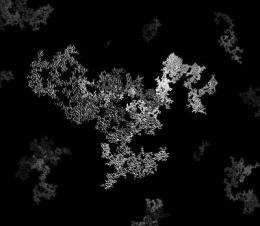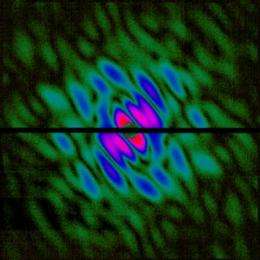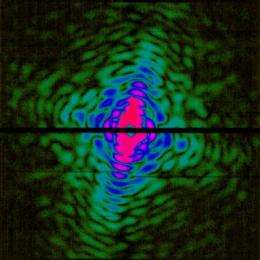X-ray vision exposes aerosol structures: Laser probes microscopic components of air pollution

(Phys.org) -- Researchers at the SLAC National Accelerator Laboratory have captured the most detailed images to date of airborne soot particles, a key contributor to global warming and a health hazard.
The discovery reveals the particles' surprisingly complex nanostructures and could ultimately aid the understanding of atmospheric processes important to climate change, as well as the design of cleaner combustion sources, from car engines to power plants.
The study, published in the June 28th issue of Nature, also pioneers a method for studying a broad range of individual particles, such as cells or proteins, and opens up exciting possibilities in the study of aerosol dynamics using highly focused X-ray lasers, such as SLAC's Linac Coherent Light Source (LCLS).
"Our study shows that LCLS can drive a paradigm shift in imaging airborne particles, allowing us to look at them one at a time instead of using a composite of many different particles," said Duane Loh, the lead author of the study and a postdoctoral scholar at SLAC and Stanford University's PULSE Institute for Ultrafast Energy Science. "We now have a richer imaging tool to explore the connections between their toxicity and internal structure."

Soot and similar particles – especially those 2.5 microns or less in diameter, which are the most dangerous to human health – are difficult to image while airborne. When placed on a surface for examination with a microscope, they tend to clump together and lose their shape.
In this experiment, researchers wafted individual soot particles up to 3.25 microns in diameter into the path of the LCLS laser beam. Its laser pulses are so brief that they captured information about the particles, only millionths of a meter across, in the quadrillionths of a second before they blew apart.

They found that no two are alike. Like magnified snowflakes, soot particles exhibit similar patterns of complexity at different scales, which is characteristic of fractals. Other research methods have probed the fractal properties of soot, but the LCLS' ability to examine those of individual soot particles, airborne and in their natural state, revealed surprising diversity and complexity in their fractal dimensions. Such observations can help validate the various models used to describe these soot particles.
The results make scientists wonder what diversity of forms will be discovered if particles produced in real-world, "messy" environments, such as a car's combustion engine or a candle flame, are imaged one at a time. The team is analyzing data from experiments at the LCLS that examined soot from diesel emissions as well as other types of airborne particles.
A primary long-term goal of the research is to take snapshots of airborne particles as they change their size, shape and chemical make-up in response to their environment, said Michael Bogan, a staff scientist at PULSE and leader of the international research team.
"Scientists can now imagine being able to watch the evolution of soot formation in combustion engines from their molecular building blocks, or maybe even view the first steps of ice crystal formation in clouds," he said.
The research team included contributors from SLAC, DESY, Lawrence Berkeley National Laboratory, the Max Planck Institutes, the National Energy Research Scientific Computing Center, Lawrence Livermore National Laboratory, Cornell University, the University of Hamburg, Synchrotron Trieste and Uppsala University. LCLS is supported by DOE’s Office of Science.
Journal information: Nature
Provided by SLAC National Accelerator Laboratory

















